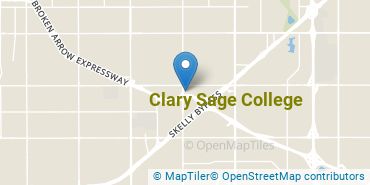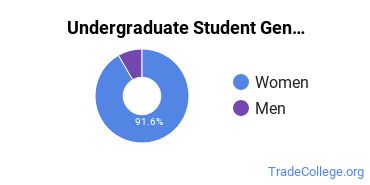Clary Sage College Trade Programs
Clary Sage College is a private not-for-profit institution situated in Tulsa, Oklahoma. The city atmosphere of Tulsa makes it a great place for students who enjoy having lots of educational and entertainment options.
Featured schools near , edit
Where Is Clary Sage College?

Contact details for Clary Sage College are given below.
| Contact Details | |
|---|---|
| Address: | 3131 South Sheridan, Tulsa, OK 74145 |
| Phone: | 918-610-0027 |
| Website: | www.clarysagecollege.com |
Can I Afford Clary Sage College?
Student Loan Debt
While almost two-thirds of students nationwide take out loans to pay for college, the percentage may be quite different for the school you plan on attending. At Clary Sage College, approximately 51% of students took out student loans averaging $5,844 a year. That adds up to $23,376 over four years for those students.
Clary Sage College Undergraduate Student Diversity
Gender Diversity
Of the 367 full-time undergraduates at Clary Sage College, 4% are male and 96% are female.

Racial-Ethnic Diversity
The racial-ethnic breakdown of Clary Sage College students is as follows.

| Race/Ethnicity | Number of Grads |
|---|---|
| Asian | 6 |
| Black or African American | 57 |
| Hispanic or Latino | 29 |
| White | 153 |
| International Students | 0 |
| Other Races/Ethnicities | 122 |
Clary Sage College Trade School Concentrations
The table below shows the number of awards for each concentration.
| Major | Basic Certificate | Undergraduate Certificate | TOTAL |
|---|---|---|---|
| Facial Treatment Specialist/Facialist | 169 | 0 | 169 |
| Massage Therapy/Therapeutic Massage | 0 | 53 | 53 |
| General Cosmetology/Cosmetologist | 0 | 47 | 47 |
| Nail Technician/Specialist & Manicurist | 0 | 29 | 29 |
| Barbering/Barber | 0 | 26 | 26 |
| Make-Up Artist/Specialist | 10 | 0 | 10 |
| Cosmetology, Barber/Styling, & Nail Instructor | 0 | 6 | 6 |
| TOTAL | 179 | 161 | 340 |
References
*The racial-ethnic minorities count is calculated by taking the total number of students and subtracting white students, international students, and students whose race/ethnicity was unknown. This number is then divided by the total number of students at the school to obtain the racial-ethnic minorities percentage.
More about our data sources and methodologies.
Featured Schools
 Request Info
Request Info
|
Southern New Hampshire University You have goals. Southern New Hampshire University can help you get there. Whether you need a bachelor's degree to get into a career or want a master's degree to move up in your current career, SNHU has an online program for you. Find your degree from over 200 online programs. Learn More > |
